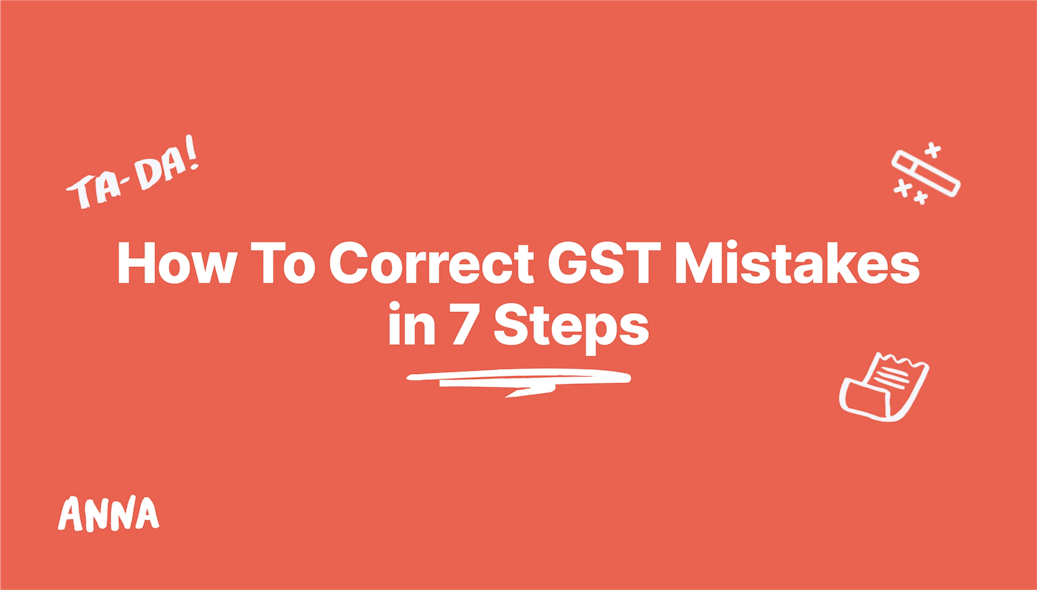

Learn how to correct GST mistakes with this step-by-step guide, covering key requirements, common errors, and tips for accurate tax adjustments.

- In this article
- 1. Confirm It’s Actually a “GST Error”
- 2. Determine If It’s a Credit Error or a Debit Error
- 3. Check the Time Limits (and Value Limits for Debit Errors)
- 4. Confirm There’s No Compliance Activity or Prior Corrections
- 5. Decide Whether to Revise or Correct on a Later BAS
- 6. Correct the Error on Your BAS (Boxes 1A or 1B)
- 7. Maintain Ongoing Vigilance and Good Record-Keeping
- Final Thoughts
When it comes to Goods and Services Tax (GST) in Australia, mistakes happen – perhaps you overstated the GST on a sale, forgot to include GST on certain transactions, or missed a vital adjustment.
Regardless of the reason, knowing how and when to correct these errors is essential to stay compliant with the Australian Taxation Office (ATO) and avoid unnecessary penalties or interest charges.
Below, we break down 7 essential steps for identifying and correcting GST mistakes on your Business Activity Statement (BAS).
We’ll clarify the difference between credit and debit errors, discuss when a mistake qualifies as a “GST error,” highlight the time limits and value limits you need to consider and walk you through the process of actually fixing these mistakes on a subsequent BAS.
1. Confirm It’s Actually a “GST Error”
⚡ Definition Check
A GST error relates specifically to an amount of GST, GST credit, or GST adjustment that was incorrectly reported on a BAS.
If correcting that mistake, on its own, would change how much GST you paid or reported, it typically counts as a GST error.
⚡ Examples of GST errors:
- Reporting $1,000 of GST on sales instead of the correct amount of $100.
- Forgetting to include an increasing GST adjustment in your net amount.
- Double-counting a taxable sale so that GST is over-reported.
⚡ What’s Not a GST Error?
- Claiming a GST credit in a later BAS (after you initially forgot to claim it). This is simply a late claim, not an error.
- A valid GST adjustment you make after circumstances change (for example, issuing a refund to a customer). If your original BAS was correct at the time you lodged it, then making an adjustment is different from fixing an error.
- GST-restricted refunds (where you charged GST to a customer and did not reimburse them, resulting in no entitlement to a refund from the ATO).
📌 Key Point
Ensure you’re dealing with a genuine GST error – one that was incorrect at the time of your original BAS lodgment.
If it’s not a GST error (for example, you simply missed claiming a GST credit and will now claim it later), you can typically fix it by including it in your next BAS without worrying about error correction rules.
2. Determine If It’s a Credit Error or a Debit Error
Once you’ve confirmed it’s a GST error, the next step is figuring out which type of error you’re dealing with:
⚡ Credit Error: You over-reported or overpaid GST.
Common scenarios:
- Recording the same taxable sale twice.
- Overstating GST on sales (e.g., you reported a bigger GST amount than correct).
- Overstating an increasing GST adjustment (or understating a decreasing GST adjustment).
Impact: Once you fix the error, you should receive a credit (or effectively pay less GST).
⚡ Debit Error: You under-reported or underpaid GST.
Common scenarios:
- Failing to include GST on a taxable sale.
- Understating GST on sales or claiming GST credits twice.
- Omitting or understating an increasing GST adjustment.
Impact: You owe additional GST once you correct the error.
Differentiating between credit and debit errors matters because the time and value limits for correction differ.👇
3. Check the Time Limits (and Value Limits for Debit Errors)
⚡ Time Limits for Credit Errors
You can correct a credit error on a later BAS lodged within the period of review for the relevant earlier period.
The standard period of review is 4 years and one day from the date you lodged that earlier BAS.
If the credit error relates specifically to GST credits, remember there is a separate 4-year limit for claiming additional GST credits. Once that 4-year limit has passed, you cannot correct or “back-claim” those credits, even if it’s a genuine error.
⚡ Time Limits for Debit Errors
The deadline depends on your current GST turnover:
- If your current GST turnover is less than $20 million: you must correct the error on a BAS lodged within 18 months of the due date of the original BAS in which the error occurred.
- If your current GST turnover is $20 million or more: you must correct the error on a BAS lodged within 12 months of the due date of the original BAS.
- If you miss these windows, you’ll need to revise the original BAS (assuming the period of review hasn’t expired).
⚡ Debit Error Value Limits
For debit errors, the net sum of your debit errors (minus any credit errors being corrected in the same later BAS) must stay below a certain threshold:
- Turnover < $20 million: Less than $12,500
- Turnover $20 million < $100 million: Less than $25,000
- Turnover $100 million < $500 million: Less than $50,000
- Turnover $500 million < $1 billion: Less than $100,000
- Turnover 1 billion and over: Less than $560,000
If your net debit errors exceed the limit, you can only correct up to that threshold on a later BAS. The remaining amount must be corrected by revising the earlier period.
4. Confirm There’s No Compliance Activity or Prior Corrections
Before you go ahead and fix an error on your upcoming BAS:
1. Compliance Activity
- If the ATO has begun an audit, review, or verification check (i.e., a “compliance activity”) on the particular issue or the reporting period where the error occurred, you generally cannot correct the error on your next BAS.
- In such cases, your best bet is to voluntarily disclose the error to the compliance officer handling your case.
2. No Duplicate Corrections
- If you have already revised the original BAS for this error or corrected it on a different later BAS, you can’t correct it again.
These checks make sure you don’t inadvertently introduce conflicting information or corrections to multiple BASs.
5. Decide Whether to Revise or Correct on a Later BAS
⚡ When It’s Best to Correct on a Later BAS:
- You’re Within the Time/Value Limits: If the error meets the conditions above (time limit, value limit, no compliance activity), you can simply fix it on your next BAS.
- You Want a Simpler Process: Correcting an error on a subsequent BAS is often more straightforward than amending an older BAS. It also helps avoid potential penalties or interest associated with lodging a formal revision.
⚡ When You Must Revise the Original BAS:
- The error falls outside the relevant time or value limits for credit/debit errors.
- You discover it’s a large underpayment (debit error) that exceeds the threshold for your turnover.
- The period has not expired, but you prefer a direct revision.
Deciding which approach to take can influence penalties or interest charges, so confirm your eligibility for a simple correction before you proceed.
6. Correct the Error on Your BAS (Boxes 1A or 1B)
Once you’ve confirmed it’s both possible and allowable to fix the GST mistake on your next BAS:
⚡ Determine the Net Outcome
- If you owe additional GST (net debit error), increase the figure at Box 1A on your new BAS by the total correction amount.
- If you overpaid GST (net credit error), increase the figure at Box 1B on your new BAS, thereby reducing your GST liability.
⚡ Document the Correction
- Maintain a record explaining which earlier period contained the error, why it was incorrect, and how you calculated the correcting entry.
- If you corrected multiple errors simultaneously, keep a clear breakdown showing each error’s date, type (credit or debit), and amount.
⚡ Keep Evidence
- The ATO may later request details about how and why you made your correction.
- Evidence can include invoices, receipts, account statements, or internal spreadsheets that illustrate the proper GST amounts you should have reported.
Example: Correcting a Net Debit Error
- Scenario: Your net sum of debit errors is $8,000 (after offsetting a $7,000 credit error), which is below the $12,500 limit for a business under $20 million turnover.
- Action: Add $8,000 at Box 1A on your next BAS.
- Result: You pay an additional $8,000 in GST to rectify the underpayment.
This process saves you from having to revise each original BAS, provided you’re within the 18-month time frame (and you haven’t triggered any compliance activity).
7. Maintain Ongoing Vigilance and Good Record-Keeping
Finally, the best way to handle GST mistakes is to avoid them in the first place or catch them as soon as they occur.
Consistent record-keeping, regular reconciliations, and thorough reviews before submitting each BAS go a long way toward preventing errors. Consider these best practices:
- Monthly/Quarterly Reconciliations: Compare the GST you’ve recorded against actual invoices, receipts, and bank statements.
- Watch for Adjustments: If a change occurs (like granting a customer a refund or discount), ensure you handle the corresponding GST adjustment in the correct period.
- Document Every Correction: Keep a dedicated record or note whenever you correct an error, including references to the earlier BAS period, the nature of the error, and the corrected BAS date.
Staying organised helps you spot discrepancies quickly and remain in compliance with time limits, so you won’t miss the window to correct debit errors or forfeit unclaimed GST credits.
Final Thoughts
Correcting GST mistakes doesn’t have to be complicated once you understand:
- What qualifies as a “GST error.”
- Which type of error (credit or debit) are you dealing with?
- The time and value limits that apply to you.
- When it’s appropriate to correct errors on a later BAS rather than revising an older one.
By following these 7 steps, you’ll be well on your way to rectifying GST underpayments or overpayments promptly and accurately, minimising the chances of incurring penalties or triggering extra scrutiny from the ATO. .
Remember: If you discover a mistake while you’re already under an ATO audit or review, or if your errors exceed the applicable time or value thresholds, you’ll likely need to revise the original BAS or liaise directly with the ATO.
For a more streamlined approach, explore how ANNA can help automate your record-keeping, simplify your BAS preparation, and help you avoid (and correct) GST mistakes so you can focus on running and growing your business.
How ANNA Can Help You Avoid & Correct GST Mistakes
⚡ Automated Bookkeeping
- Integrated Invoices & Receipts: ANNA matches invoices and receipts to transactions automatically, reducing manual data entry and the risk of keying errors.
- Real-Time Categorisation: Purchases and sales are automatically categorised, making it easier to monitor your GST credits and liabilities on the go.
⚡ Simplified BAS Preparation
- One-Click Reporting: Generate GST summaries directly within ANNA, so you know exactly what goes into your BAS before lodging.
- Timely Reminders: ANNA alerts you ahead of each BAS deadline, helping you lodge on time (and avoid late penalties).
⚡ Centralised Financial Dashboard
- Single Source of Truth: Connect all your bank accounts and see every transaction in one place, so any anomalies or missing entries are easier to spot.
- Clear Error Insights: Quickly detect potential GST discrepancies – such as duplicates or unusual expense items – so you can correct them before submitting your BAS.
⚡ Easy Record-Keeping & Compliance
- Digital Archive: Maintain a secure and searchable database of invoices, receipts, and contracts, meeting the ATO’s record-keeping requirements.
- Audit-Friendly: If the ATO ever initiates a compliance check, ANNA’s organised documentation ensures you have everything you need at your fingertips.
⚡ Support & Guidance
- User-Friendly Interface: No need to decipher complex accounting software. ANNA’s intuitive platform is built for small businesses, contractors, and startups.
- Expert Help: From set-up to troubleshooting, ANNA’s customer support can point you in the right direction for queries about GST, BAS, or general business accounting.
Join ANNA today and discover how effortless managing your business can be – from startup to success!







